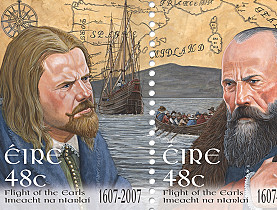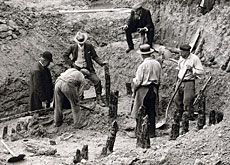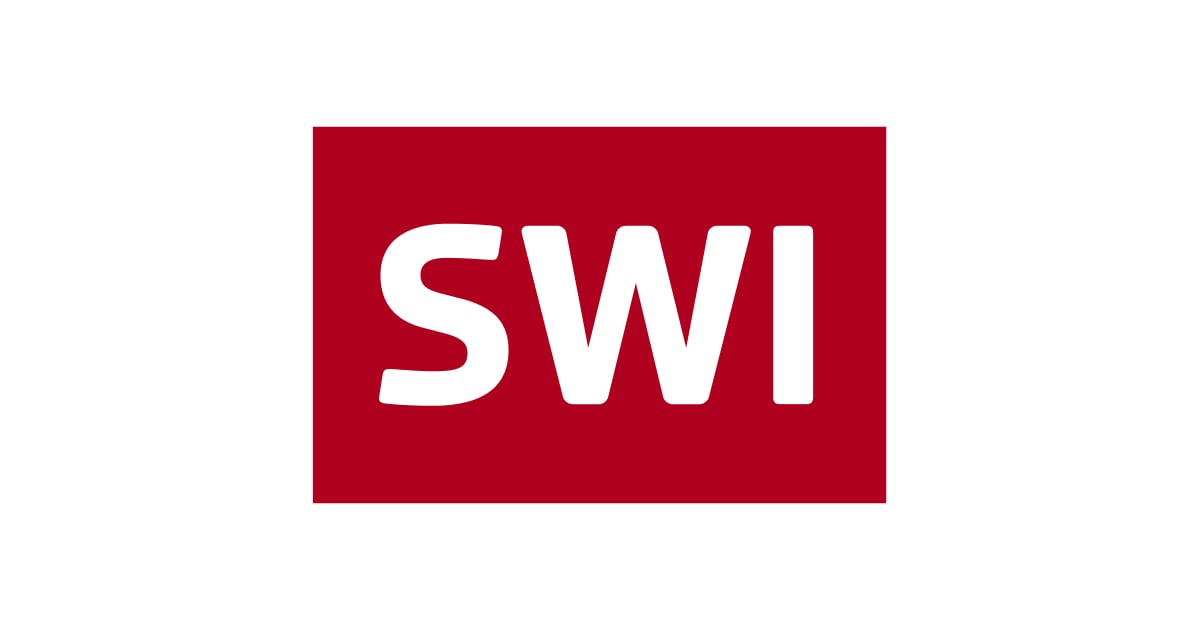When Irish history met Swiss hospitality

During the "Great Winter" of 1608, a group of Irish nobles passed through Switzerland on a journey of exile which marked a turning point in Irish history.
On March 17 the Irish celebrate their national day, and this year Switzerland has a significant place in the celebrations which are linked with the 400th anniversary of the “Flight of the Earls”.
Tadhg Ó Cianáin, the scribe who was accompanying the Gaelic princes, said of the Swiss people that they were “the most just, honest, and untreacherous in the world, and the most faithful to their promises”.
The Irish group had set sail from Donegal in the northwest of Ireland in September 1607 and later left some of their party in Louvain in Belgium.
A group of 30 men and women arrived in Basel in March 1608 and travelled from there to Lucerne. They then crossed Lake Lucerne heading for the Gotthard Pass. Their aim was to reach Milan, then under Spanish control, and seek military assistance from the Spanish.
On St Patrick’s Day 1608 the party, led by earls Hugh O’Neill of Tyrone and Rory O’Donnell of Tyrconnel, crossed the Devil’s Bridge near Andermatt in the lower reaches of the Gotthard Pass.
Lost fortune
This part of the journey did not go smoothly, as the Irish ambassador to Switzerland and keen historian James Sharkey explained to swissinfo.
“A packhorse belonging to O’Neill fell down an ice-bound ravine in the middle of a winter storm. They tried desperately and succeeded in getting the horse up but they lost a substantial fortune in gold.”
“It has never been found to this day. I sometimes joke to my Swiss friends that it’s only a coincidence that Zurich in the years afterwards became one of the great financial centres of Europe.”
This year the ambassador will join members of the Swiss-Irish community and descendants of the Ulster families that took part in the Flight at Andermatt to retrace the steps of the ill-fated travellers.
The timing of the Irish chieftains’ journey was unfortunate. A rapprochement was taking place between Spain and England as France began to emerge as a greater mutual enemy. Far from returning to Ireland to reclaim their lands and re-establish the Gaelic way of life, they all died in exile.
“Although the Irish were greeted with great honour when they arrived in Spanish-controlled Milan, the secret order of the day was that they were not to be allowed to journey to Spain and the group was diverted to Rome,” Sharkey said.
Extracts from Ó Cianáin’s account are on display in the Flight of the Earls exhibition at the Zurich James Joyce Foundation.
Distant past
Cultural ties between Switzerland and Ireland stretch back much further than the 1600s.
A thousand years before the Flight of the Earls, a band of Irish monks, led by St Columbanus also crossed through Switzerland on their missions, founding European monasteries, notably the abbey of St Gallen.
As a result of the wave of Irish monks and their disciples who passed through and lived in Switzerland throughout the Middle Ages, Switzerland is now home to a significant collection of Early Irish manuscripts, including the eighth century Irish Gospel Book of St Gallen, which is ranked among the greats.
Edel Bhreathnach of the Micheál Ó Cléirigh Institute in Dublin told swissinfo that one of the principal sources for scholars of Old Irish is a Latin Grammar housed in the Abbey Library (Stiftsbibliothek) of St Gallen.
“The St Gallen manuscript is important because we don’t have many surviving manuscripts in Ireland prior to the 12th century so we look to the Continent for the first evidence of written Irish.”
It is worth returning to Ó Cianáin’s words, translated from the Irish, for his final summing up of “the country of the Swiss”.
“It was strong, well fortified, uneven, mountainous, extensive, having bad roads, and no supremacy, rule or claim to submission by any king or prince in the world over the inhabitants.”
The Irish Embassy in Bern estimates that some 4,000 Irish live in Switzerland.
There are about 1,400 Swiss living in Ireland.
Swiss exports to Ireland were worth SFr898 million ($878 million) last year.
Irish exports to Switzerland were much higher, at SFr5,562 million.
Both countries are neutral.
“In themselves they form a strange, remarkable, peculiar state. They make their selection of a system for the government of the country each year.
They have 14 important cities. Half of them are Catholics and the other half are heretics, and by agreement and great oaths they are bound to one another for their defence and protection against any neighbour in the world who should endeavour to injure them or oppose them in upholding the public good with moderation and appropriateness.
They allow no robbery or murder to be done in their country without punishing it at once. Because of their perfect honour they alone are guards to the Catholic kings and princes of Christendom.”
(From the Corpus of Electronic Texts, University College Cork. Edited by Paul Walsh.)

In compliance with the JTI standards
More: SWI swissinfo.ch certified by the Journalism Trust Initiative












You can find an overview of ongoing debates with our journalists here . Please join us!
If you want to start a conversation about a topic raised in this article or want to report factual errors, email us at english@swissinfo.ch.